Livebearers
Livebearers are the most popular tropical fish for beginners.
Livebearers include guppies, endlers, mollies, platies, swordtails.
They breed easily and have lots of live young.
Guppies
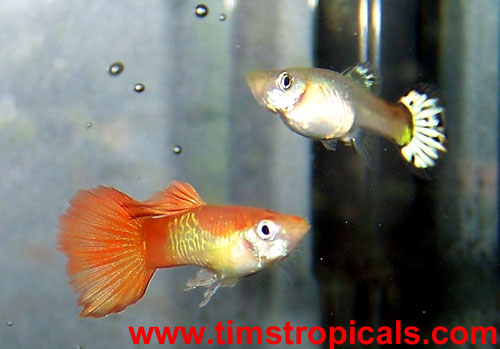
Guppy pair
Guppies originally came from South America and survived well in stagnant brackish water.
Guppies are an excellent choice for the beginning aquarist.
There are numerous colorful variations and tail shapes.
They are closely related to the Endler's Livebearer
and the Mosquitofish.
Guppies are extremely popular not only for their color, but for their hardiness
and the ease with which they produce live young.
Unfortunately livebearers only live a few short years.
If yours is sitting the bottom of the tank and not moving much, it's probably at the end of its very short life.
Guppy Feeding
Guppies can survive easily on flake foods, but they also appreciate freeze-dried bloodworms, tubifex,
and brine shrimp.
The males mature in 2 months and the females in 3 months with the females being larger.
The females have almost no color and have a large dark gravid spot near their anal fin as their young develop.
The male has a gonopodium which is extended to fertilize the female internally.
Females can have young every 5 weeks.
Keep more females than males in a tank, because the males harass females in a continual attempt to breed.
Try to arrange for areas where the females can escape from the males occasionally.
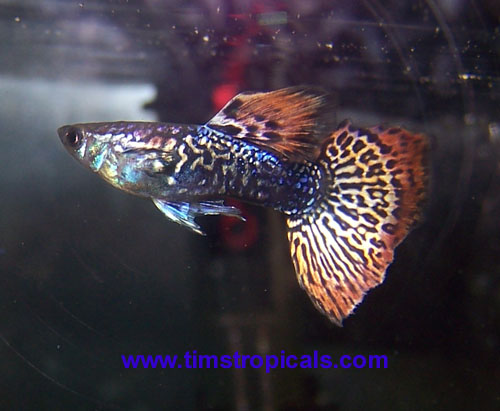
Male Rainbow Guppy
Guppy Breeding
Guppies will eat their own young, so a thick dense floating plant cover, such as java moss, is required for the fry to survive.
Alternately, a simple plastic breeding trap can be purchased at aquarium stores and the pregnant female can be placed in it.
The young will fall through to safety at the bottom of the trap.
The young can be fed fine grained flake food.
Guppy - Profile
-
Scientific Name: Poecilia reticulata
-
Family: Poeciliid
-
Temperature: 23 - 26 C; 74 - 79 F
-
pH: 7.0 - 8.0
-
Size: 5 cm; 2 inches
-
Life Span: 3 - 5 years
-
Breeding: Very Easy, Livebearer
Guppy - Compatibility:
The guppy is compatible with other Livebearers,
Black Phantom Tetras,
Cardinal Tetras, Chinese Algae Eaters, Corydoras Catfish,
Dwarf Neon Rainbows, Ghost Shrimp, Glow Light Tetras, Harlequin
Rasboras, Neon Tetras, Plecostomus, one Red Tailed Shark,
Silver Hatchets, White Clouds
Mollies
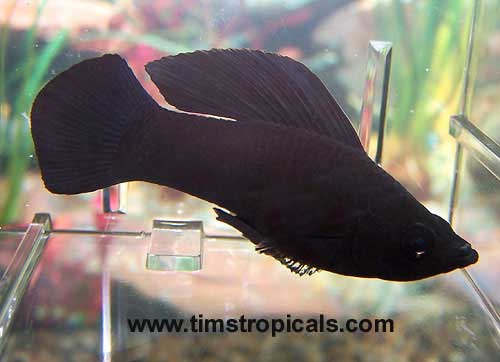
Sailfin Molly Male
Sailfin Molly - Aquarium Setup
Mollies originate from Mexico and Central America. They can survive in brackish water and it improves their health to add a tablespoon of salt per gallon of water. They prefer bushy plants, plenty of swimming room, warmer hard water and some of their own kind. It is best to have a couple of females
per male, as the males continually harass the females in order to breed.
Types of Sailfin Molly
The Molly comes in a wide variety of colors and three main types: short fin, sail fin and Mexican. Some common names are the Black, Black Lyretail, Gold, Dalmation, Silver Sailfin, Black Sailfin and Gold Sailfin Molly. Sailfin mollies are larger and have a long, broad dorsal fin. The Mexican salfins are somewhat harder to keep and breed.
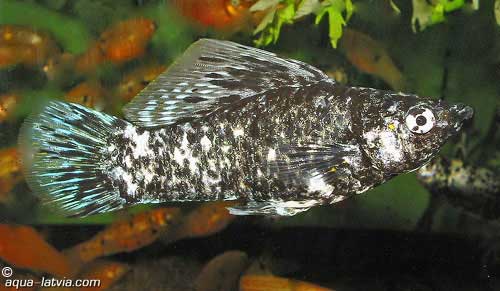
Dalmation Molly
Sailfin Molly Breeding
Males have a gonopodium which is used to fertilize the female. Females are larger and broader. One fertilization can result in several sets of births. When pregnant, females have a dark gravid spot near their anal fin. Females can have young every 3 to 4 weeks. They will seek an area of seclusion to give birth and can have anywhere from 10 to more than 50 young. Mollies will eat their young, so it is important to either have
a heavy plant cover or a separate breeding tank. A simple plastic breeding trap can be purchased at aquarium stores.
Molly Livebearer - Profile
-
Scientific Name: Poecilia
-
Family: Poeciliid
-
Temperature: 24 - 29 C; 75 - 84 F
-
pH: 7.5 - 8.2
-
Size: 8 cm; 3 inches
-
Life Span: 3 - 5 years
-
Breeding: Easy, Livebearer
Molly - Compatibility:
The molly is compatible with other Livebearers,
Angelfish,
Barbs, Bettas, Danios, Chinese Algae Eaters, Clown Loaches, Corydoras Catfish,
GloFish, Large Tetras, Platies, Plecostomus, one Red Tailed Shark,
Silver Hatchets, Swordtails, White Clouds
Swordtails
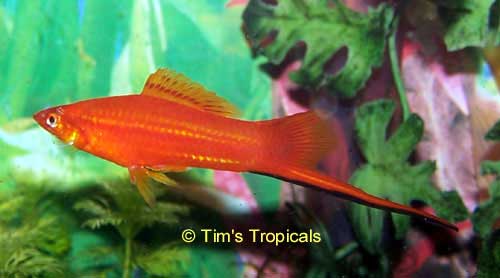
Male Swordtail
Swordtails are a popular beginner's fish because of their hardiness and the ease with which they breed. Swortails originally came from South America. Although originally a drab olive green in appearance, they have been bred into a number of variations, such as the Tuxedo (black on the body), Lyretail (forked tail) and Red Swordtail. Swortails are closely related to the Platy, but differ in that they have the distinctive swordtail on the males. In fact Swordtails and Platies can interbreed. Swordtails like brackish water, so it is advisable to add about a teaspoon of salt for a 5 gallon aquarium. They eat flake foods, but will enjoy live brine shrimp and bloodworms.
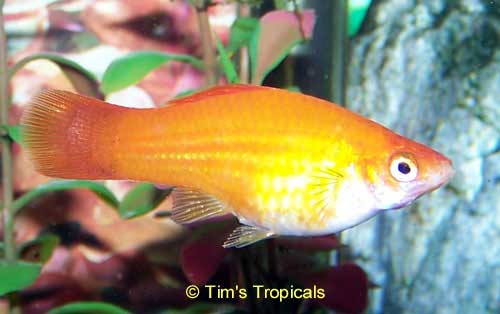
Female Swordtail
Swordtails - Breeding
More than one female should be kept with each male, to help reduce the stress on females from harassment by the male. In addition to the sword tail, males have a gonopodium which is used to fertilize the female. Females are larger and broader. One fertilization can result in several sets of births. When pregnant, females have a dark gravid spot near their anal fin. Females can have young every 4 to 6 weeks. They will seek an area of seclusion to give birth and can have anywhere from 10 to more than 50 young. Swordtails will eat their young, so it is important to either have a heavy plant cover or a separate breeding tank.Java moss will work well or a simple plastic breeding trap can be purchased at aquarium stores. The young can be fed finely crushed flake food.
Swordtails - Profile
-
Scientific Name: Xiphophorus hellerii
-
Family: Poeciliid
-
Temperature: 21 - 27 C; 70 - 81 F
-
pH: 7.0 - 8.0
-
Size: 13 cm; 5 inches
-
Life Span: 3 - 5 years
-
Breeding: Easy, Livebearer
Swordtails - Compatibility:
Swordtails are compatible with other Livebearers,
Angelfish,
Barbs, Betta, Danios, Chinese Algae Eaters, Clown Loaches, Corydoras Catfish,
Danios, Large Tetras, Mollies, Platies,
Plecostomus, one Red Tailed Shark,
Silver Hatchets
Platies
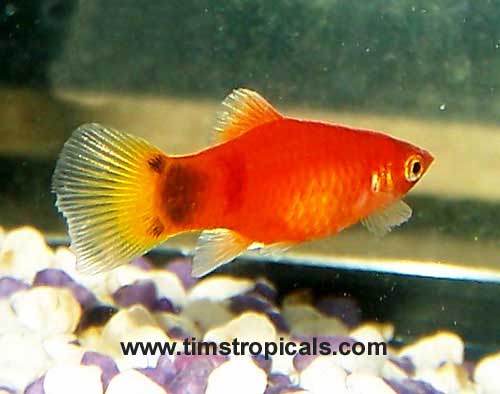
Mickey Mouse Platy
Platies are a popular beginner's fish because of their
hardiness and the ease with which they breed. Platies originally
came from clear waters in Central America. Although originally a
drab olive green in appearance, they have been bred into a number of
variations, such as the Tuxedo (black on the body), Wagtail (black on the
tail), Mickey Mouse (see above), Red and Sunset Platies.
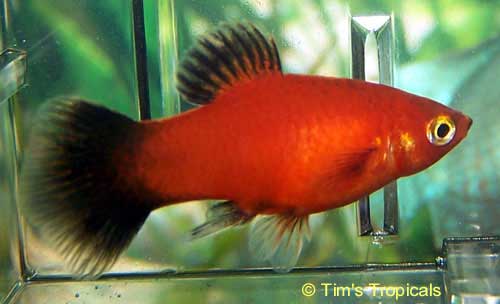
Red Wag Platy Male
Platies vs Swordtails
Platies are
closely related to the Swordtail, but lack the
extension at the bottom of the tail fin. In
fact Swordtails and Platies can interbreed. They
eat flake foods, but will enjoy live brine shrimp and bloodworms.
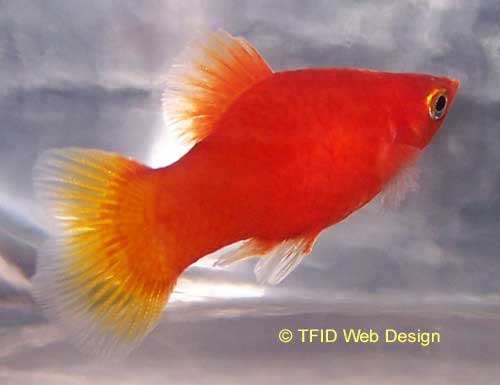
Red Platy Male
Platy Breeding
More than one female should be kept with each male, to help
reduce the stress on females from harassment by the male. Males have a
gonopodium which is used to fertilize the female. Females
are larger and broader. One fertilization can result in several sets of
births. When pregnant, females have a dark gravid spot near their anal
fin. Females can have young every 4 to 6 weeks. They will seek an
area of seclusion to give birth and can have anywhere from 10 to more than
50 young.
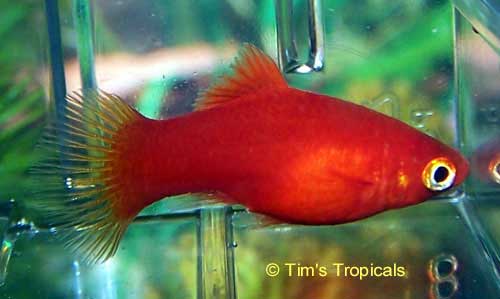
Red Platy Female
Platies will eat their young, so it is important to either have
a heavy plant cover or a separate breeding tank. Java moss will work well
or a simple plastic breeding trap can be purchased at
aquarium stores. The young can be fed finely crushed flake food.
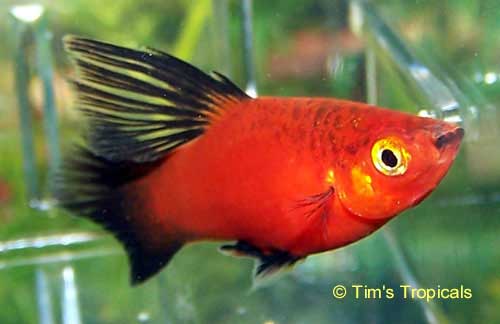
Red Hifin Platy Male
Platy - Profile
-
Scientific Name: Xiphophorus Maculatus
-
Family: Poeciliid
-
Temperature: 18 - 25 C; 64 - 77 F
-
pH: 7.0 - 8.0
-
Size: 6 cm; 2.5 inches
-
Life Span: 3 - 5 years
-
Breeding: Easy, Livebearer
Platy - Compatibility:
Platies are compatible with other Livebearers,
Angelfish,
Barbs, Bettas, Danios, Chinese Algae Eaters, Clown Loaches, Corydoras Catfish,
GloFish, Large Tetras, Mollies, Plecostomus, one Red Tailed Shark,
Silver Hatchets, Swordtails, White Clouds
Endlers Livebearer
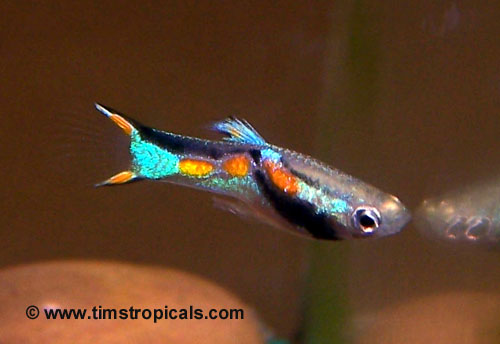
Endlers Livebearer
Endlers Livebearer - John Endler
The Endlers Livebearer originates from Laguna de Patos, near Cumana in Venezuela, but it is now thought that they are extinct in the wild.
They are named after John Endler, but John credits Franklyn F. Bond with having found them first.
To read an Email from John Endler visit the Krib.
Endlers don't officially have a scientific name yet, but most sources call them Poecilia "Endlers".
They are a distinct species closely related to the Guppy.
Endlers can interbreed with guppies, but the offspring are infertile.
After John reported them, stock was mainly bred in Germany.
Males are mainly orange and neon blue, but with the ease of breeding, the variations are numerous.
Male colors are brighter than guppies. Females are plain.
The size is smaller than a guppy and they lack the fancy tail.
The profile is more streamlined.
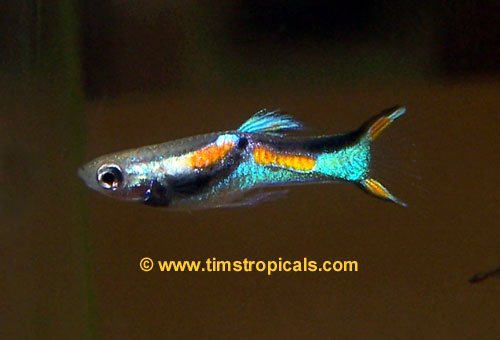
Endlers Livebearer
Enlders frequent the top of the tank, similar to guppies.They prefer hard water and
temperatures near 80 F are best. Endlers prefer warmer temperatures than guppies. They will do fine on flake foods, but also appreciate spirulina, tubifex, and brine shrimp. They love live food.
Endlers Livebearer - Breeding
Like guppies, Endlers are very easy to breed. They have young monthly. A ratio of one male to two females is recommended to reduce the stress on the females. Java moss is great for
helping the young survive, but our readers report that Endler's will not eat their own new born fry.
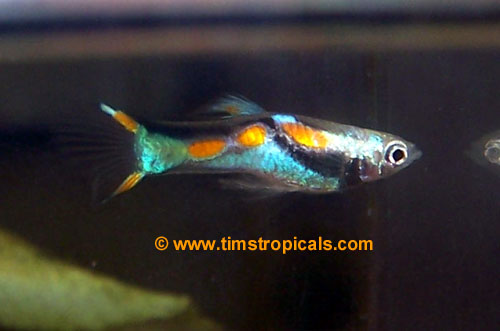
Endlers Livebearer
Endlers Livebearer - Profile
-
Scientific Name: Poecilia endlers
-
Family: Poeciliid
-
Temperature: 23 - 28 C; 74 - 82 F
-
pH: 7.0 - 8.0
-
Size: 3 cm; 1 inches
-
Life Span: 2 years
-
Breeding: Very Easy, Livebearer
Endlers Livebearer - Compatibility:
Endlers Livebearers are compatible with other Livebearers,
Black Phantom Tetras, Cardinal Tetras, Corydoras Catfish, Dwarf Neon Rainbows, Ghost Shrimp, Glow Light Tetras, Harlequin Rasbora, Neon Tetras, Plecostomus, one Red Tailed Shark, Silver Hatchets, White Clouds
Livebearers, Pregnancy & Fry! by Bernie
This is something I put together from things I have remembered or read over the years and from my own experience when I have kept guppies and platys. Please do not take it as gospel, but it might give those of you keeping Livebearers some hints/guidelines that may be useful.
What to look for in a healthy Livebearer:
Before buying your Livebearer (or any fish) you should try and inspect it closely for any signs of illness. These are just some of the obvious things to look out for!
Fish to Buy:
Fish that have a round/plump abdomen that curves outwards, shows that they have been eating well. The female usually looks fatter than the male. The female will appear even rounder if holding fry. Fish that breathe slowly and regularly, but sometimes fish may be breathing a bit heavily in the shop tanks because they are overstocked. Healthy looking reddish colour under the gill flaps. Fins that erect most of the time with the fins having a well defined shape/edge to them and free from tears (Torn fins can occur periodically from getting caught/cut on decor etc. and will usually heal naturally). Eyes look healthy and clear. Scales are sitting flat. The skin/scales and mouth should be free of any white spots, mold, fungus, or white film.
Fish to Avoid:
Livebearers that have a concave or sunken looking stomach, could mean that it is having trouble eating or the stomach hasn't formed properly. Livebearers that look overly bloated, this could also be a sign of illness. Females that are heavily pregnant, where her stomach has a box shape to it and has a large gravid spot. Stress from moving could cause her to abort the fry or even kill her. Deformed bodies, which is often a sign the fish has been malnourished or lacked essential vitamins. It could also be a sign of a shorter lifespan. Missing a gill cover. This could be due to a deformity at birth or it could have been torn off accidently. This will usually not harm the fish and may even grow back (if torn in a fight), but it could possibly lead to infection at some point. Frayed or shredded fins are often signs of a disease, although there may be other causes such as fighting etc. Clamped fins and shimmies (staying in one spot and moving from side to side) continuously is a definite sign of stress, and that fish will often end up getting a disease and should not be bought. Cloudy eyes, or abnormally protruding eyes. This could be a sign of Pop-eye. Scales sticking out (pine cone effect) or skin and mouth have white spots, mold, fungus, or white film on it. Sure sign that the fish is definitely ill. Fish staying on its own near the bottom of the tank continuously. This is often a sign that the fish is stressed, exhausted or sick and it is best not to buy that fish.
Resist Buying a Sick Fish
Of course it can be hard to resist buying a sick fish, as most of us want to save them if we can and give them a good home. This is commendable, but sometimes this can be the wrong thing to do, particularly if those fish are going to join our other fish. It can often bring illness into the tank. Although if our fish are very healthy they may not catch an illness, but it is always better to be on the safe side and quarantine new fish for 2 weeks before introducing them to the main tank.
How to sex Livebearers?
Adult male livebearers have a gonopodium which was the anal fin, but it has adapted into the sex organ and has a pointed shape. Males usually are smaller and slimmer. The anal fin on a female is round. (If you go to the gallery section and click on livebearers, you can see the difference between them in some of the pictures).
Male - Female Ratio
Most livebearers, although not classed as shoaling fish, do prefer the company of their own species, so it is advisable to always buy at least 2, preferably 3. If keeping both sexes, it is best to always have more females than males and 1 male to 2-3 females is a good ratio, but with swordtails it is better to have 1 male to 4-5 females, because of the aggressive nature the male often has. You should only buy a single female if she is pregnant, because you will soon have many more. Try to buy fish that are similar in size, as this will help limit any aggression.
Tank Size for Livebearers
My personal opinion is that the minimum size tank for Mollies and Swordtails would be a 15-20 gallon tank, as they tend to grow larger than guppies or platys, and they need more space. They also can be aggressive and giving them more space will help ease any harassment between the sexes. Mollies in particular may need specific water conditions to stay healthy, and researching them first is a good idea. I personally think it is best to keep them in a species specific tank, this enables you to maintain those specific requirements.
Guppies and platys are the ones to go for if you only have a 10 gallon tank, but I wouldn't put any more than 5 (6 at the most) in there. All livebearers can be big waste producers, so good filtration and water quality is needed.
Livebearers - Pregnant Behaviour
There is a 99% chance that if you buy a female livebearer she will be pregnant, even if no males have been around in a while, female livebearers can hold onto the sperm for months, allowing her to produce fry when conditions are favourable, or all males have died. Gestation usually takes approx. 28 days, although it can be from 21 days up to 40 days (I mention this in more detail further on). They can have anywhere between 5-100 fry, but often stays around 10-20. Mollies and Swordtails have been known to take longer, even up to 2-3 months to give birth, possibly because they are a bit larger and may be holding a large number of fry.
Week 1 of Livebearer Pregnancy
You shouldn't notice many changes, although if a male is present, he may harass her more than usual and she will become a bit more intolerant of other fish and may seem aggressive towards them.
Week 2 of Livebearer Pregnancy
The female may show an increase in appetite. The gravid spot (dark patch below the stomach and near the vent area) is the fry developing. Their eyes show through as the females skin becomes more transparent as it stretches with the fry) will start to develop. Although not all livebearers show a gravid spot (please refer to Gravid Spot at end of the article).
Week 3 of Livebearer Pregnancy
The gravid spot becomes very dark and the female's stomach may look like it is going to burst and start to get a box shape to it. Her appetite will have increased considerably and she will be much more competitive for food and possibly much more aggressive; you may notice her spending much more time by herself around plants or in a good hiding place, she may also just sit near the bottom of the tank without moving very much. If the female guppy is only holding a few fry, she may drop them at this time.
Week 4 of Livebearer Pregnancy
The female begin to drop the fry, although it can take up to 5 weeks, (livebearers can hold onto there fry until they feel conditions are favourable, which can make it difficult to give a specific time frame for dropping of the fry). The birthing or dropping of fry can take between a few hours to a day, sometimes longer, she can just give birth to a few fry at a time and then deliver the rest later on (can be days, or even a week or so later).
During this time it is best to keep her as stress free as possible and moving pregnant females to a breeding tank or net a couple of days before she is expected to give birth is an option particularly if she is in a community tank, sometimes moving her could cause more stress. She can also abort the fry if she experiences a lot of stress or doesn't get enough food. Keeping the tank temp. around 78*, and feeding her a varied/nutritious diet throughout her pregnancy such as bloodworms, brine shrimp, daphnia and high quality flakes etc. and keep water quality conditions high will aid the process.
Livebearers can go through immense stress during birthing and can have problems dropping the fry due to the large number or fry getting stuck. The female can die during/after birth.
Fry Tank or Breeding Net?
The decision on a fry tank or breeding net is often a matter of personal preference. I personally have just left things up to "mother nature" whenever my fish gave birth and in most cases some fry survived being eaten etc. "Survival of the fittest" I guess! A fry tank is simply a spare tank that is cycled and has adequate heating, filtration and lighting with some plants or floating plants (live/artificial) so they can hide, but not absolutely necessary if they are the only fish in the tank. A good size fry tank is around 10 gallons or bigger if there are going to be hundreds of fry.
Fry Tank
You can either place the female in the fry tank a few days before you think she is due to drop the fry or you can leave her in the main tank and then collect the fry and transfer them to the fry tank. If moving them to a fry tank, it should have the same water conditions as the tank they came from so as to help prevent the fry dying from stress/shock and I don't think it is a good idea to move them too much during the early stages of their development.
Breeding Net
Breeding nets are another option, but there is limited space in them if you are putting the expectant female in it or you have more than one pregnant female about to drop fry at the same time. It is also recommended to keep them in a breeding net for no longer than 4 days or so, as being in the net can cause stress. Mollies and swordtails can often be too big to keep in a breeding net. If using a net, the best position for it is out of direct light, and somewhere it will get adequate water flow. Putting a plant in the net will make her feel more secure and it may also keep the bottom of the net stable. I think the nets are better than the plastic breeding traps because I find that the fry can sometimes fit through the slits and end up in the main tank.
Feeding and Raising Livebearer Fry
Livebearer Fry may not want to eat for 2 days or so after birth, but I think it is best to start feeding them straight, although they will often find minute pieces of food in the gravel or on the plants. It is best to try and feed fry 3-5 times a day if possible. You can feed them on a number of foods designed for fry such as Liquifry or the powdered fry food, infusoria, baby brine shrimp is very good, crushed up hard boiled egg yolks is another food for fry (a member mentioned in a post, an egg yoke mixture they used, but I can't find it at the moment). Crushing up normal fish flakes into a very fine powder also works. I have always just used the powdered fry food, b.brine shrimp and crushed flakes.
The fry prefer and will grow faster in warmer temperatures around 77-78* along with regular feeding, nutritious food and clean water conditions. It is safe to put fry back into the main tank when you are sure they are big enough not to get eaten by the other fish. Usually when they are approx. 1 inch is safest, but again it can depend on the type of tank mates it will have. Most livebearers such as platys and guppies take about 6 months to fully mature, although mollies and swordtails may take up to a year. There will be some fry that may not survive despite everything, due to some of their internal organs (often the lungs or swim bladder) not developing properly.
Sexing Livebearer Fry
It is virtually impossible to tell the fry's sex for the first 3 months. Male fry may grow faster than females and may be the first to start showing a bit of colour which usually shows on the tail fin first. The male's gonopodium may develop last and start showing around 5 months of age, but some males can be very slow in developing and you may think that a female is turning into a male all of a sudden many months later.
6 months of age is around the time that they can truly start breeding but there may be exceptions to the rule and it is best to separate the sexes as soon as you start noticing the difference, unless you want them to breed, but this is not a good idea as you want to try and avoid any inbreeding.
The Gravid Spot
I will try to clarify the gravid spot question, as it is often asked about. I believe it basically comes down to this...All livebearers (talking about Guppies, Swordtails, Mollies and Platys here) may have a gravid spot to a certain extent. Guppies certainly do and it is particularly pronounced because of their colouring and transparency of their skin. It can show in the other livebearers to varying degrees, but not always...and for the same reason; because it may be hidden by the fish's natural colouring and their skin isn't as transparent as that of guppies.
Some livebearers may seem to have a gravid spot constantly, even if they aren't holding fry and it may just mean that they are mature and have mated at some stage and not necessarily a sign of pregnancy, also some livebearers have a naturally darkened area just above the anal fin. The best sign is that they start getting larger and rounder in the abdomen.
Thanks...The End!! - Bernie
Do Livebearers need Salt? by Bernie
The age old question Do Livebearers Need Salt is often asked but may never fully be resolved. In my opinion the answer is NO - They do Not. In general most common livebearers i.e. Molly, guppy, platy and Swordtails, with proper water conditions, diet & not overstocking, do very well without it, but what they do need is hard water to thrive, and do not do as well in Soft water. They are freshwater fish & the addition of salt isn't necessary. Salt is best only used as a tonic for sick fish, which should always be done in a quarantine tank and not in the community tank.
Mollies Do Prefer Salt
Some species such as Sailfin Mollies do prefer salt YES, but again it isn't really necessary. If you are going to use salt, it can only be used in a species specific tank - not a community tank, as most freshwater fish definitely don't need or cannot tolerate salt and it will be harmful to the other fish if used continuously.
Introduce Salt Slowly
When first using salt for your Livebearers it is best to introduce the salt slowly over time to get them acclimated to it, and you need to remember to check the salinity of the tank regularly because the only way to remove salt from a tank is by water changes as salt doesn't evaporate or get absorbed, so when doing p.w.changes you need to make sure that the salt added is the right measurement for the amount of water you are replacing, or the salt will build up and become harmful.
Measurement of Salt
The measurement of salt is usually 1 teaspoon per 3 ltrs or 1 tablespoon for every 5 galls. but Livebearers are a very diverse group and each species requires their own specific conditions to thrive, so doing your research into the particular species of Livebearer you want to keep is absolutely necessary.
|













